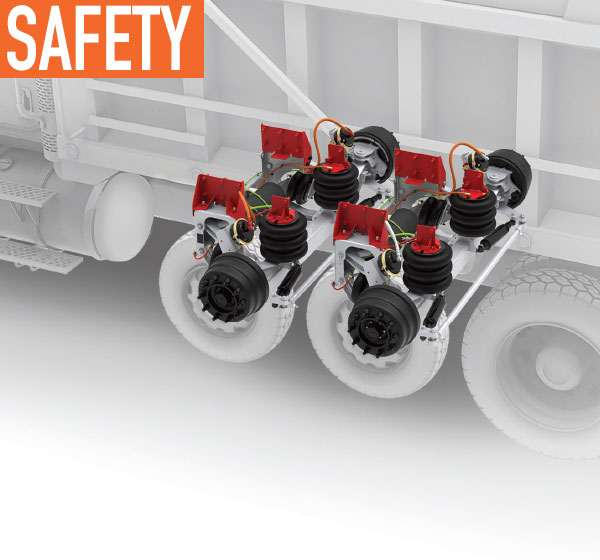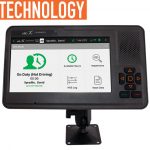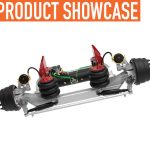Traditional auxiliary suspension systems are easy to operate but hard to operate correctly. While some systems allow users to choose variable deployment levels, the majority of auxiliary suspension systems are binary; they are either up or down.
Most hauling scenarios rely on operators to determine whether a load is properly handled by the vehicle’s primary suspension system or whether its auxiliary axles should be extended. The choice requires significant guesswork, and in an era of increasing driver shortages and diminishing experience levels, human error is common.
When a vehicle is either empty or fully loaded, the choices relating to auxiliary axles are intuitive, but variable payload densities and the need for partial load flexibility can make for tricky choices and lead to far-reaching consequences. In fact, the improper use of lift axles can adversely impact a fleet’s bottom line.
“If an auxiliary suspension system is engaged when not needed, this can negatively affect tire wear, gas mileage, and maintenance intervals,” Bill Ott, vice president of engineering for Link Mfg, LTD, says. “Conversely, if auxiliary axles are not deployed when needed, the vehicle’s structural integrity is at risk, it may not comply with bridge laws, and is therefore exposed to being cited by authorities.
“Improper use of auxiliary suspension systems can cause physical harm to drivers and passengers due to amplified levels of exposure to the mechanical forces of vibration and shock,” Ott adds.
HOW IT WORKS
As the maker of heavy-duty truck suspensions, auxiliary suspensions, accessory products, and the widely respected Cabmate® Cab Air Suspension System, Link Mfg anticipated the need for smart suspension management technology more than 10 years ago. As more advanced sensors and electronic control units (ECUs) became available, Link engineers harnessed these improvements, writing proprietary algorithms that govern a suspension system’s performance.
In 2018, Link introduced its first product with its signature Road-Optimized Intelligence (ROI) technology: the Cabmate Semi-Active Cab Suspension System. With Cabmate, Link’s ROI system receives a continuous stream of environmental data via accelerometers that measure cab acceleration at the top of the suspension. The system also incorporates position sensors that constantly monitor the position and velocity of the vehicle’s cab suspension relative to the frame.

“Using Link’s ROI technology, the Cabmate Semi-Active Cab Suspension System interprets information from its accelerometers and position sensors in real time and continuously adjusts the settings for the shock absorbers and fills or exhausts air from the system’s air springs to optimum ride stability and comfort,” Ott says. “With Link’s ROI, adjustments are made hundreds of times per second, resulting in a dynamic dampening state that optimizes the cab’s ride quality for each instant.”
The system protects the cab from damaging stress and the occupants from dynamic forces that can cause traumatic injury. The Cabmate Semi-Active Cab Suspension System is expected to be available on select 2020 and 2021 model vehicles and will forever change the operating environment for drivers and passengers whose vehicles frequently transition from on- to off-road.
GOODBYE GUESSWORK
Link is in the final stages of developing smart, load-balancing axles using its revolutionary ROI technology. These groundbreaking axles sense and maintain optimal tire-to-ground pressure, reducing tire wear and maximizing gas mileage. Guesswork is out of the equation with Link’s intelligent load-balancing auxiliary suspension systems.
Link’s ROI automatically deploys or retracts the auxiliary suspension system as needed. Unlike traditional all-on or all-off auxiliary axles, Link’s smart axles determine loads and vary load spring air pressure to precisely accommodate weight.
A novice operator often forgets to retract auxiliary axles when backing up, which causes tire drag and results in excessive wear. Intelligent axles like Link’s new 8K, 10K, 13.5K, and 20K Self-Steer Auxiliary Axles automatically respond to the vehicle’s movements and don’t need to be retracted. In snow, mud, and other challenging conditions, Link’s ROI technology senses the absence of surface friction and retracts as needed to shift the requisite tractive force to the drive axles.
“With Link’s load-balancing auxiliary suspension systems, fleets will be able to get new drivers trained and working in less time,” Michael Hof, vice president of new business development for Link, says. “Now when it comes to proper auxiliary axle use, a novice driver with a Link smart axle will be able to outperform even the most seasoned professional using a traditional lift axle.”
Most auxiliary suspensions add stability to vehicles under load by providing additional shocks, air springs, and lateral control rods. Link’s load-balancing auxiliary suspension systems with ROI go much further, keeping a vehicle’s load balanced and evenly distributed while preserving the vehicle’s structural integrity. Link’s ROI technology reduces strain on frames and primary suspension components, enhancing vehicle stability, decreasing vehicle sway, and lowering operating costs.
Link’s intelligent auxiliary suspension systems will be available in 2019, and include many applications in the heavy-duty and off-road arena. Its smart 13.5K Self-Steer Auxiliary Axle will also be available with air disc or drum brakes. Using Link axles with ROI technology, fleets and independent owner-operators can expect superior handling, better gas mileage, reduced tire wear, more uptime, and a lower overall cost of ownership.
SMARTER IS FASTER
For optimum performance results, Link recommends engineering axles for the needs of the vehicles served, particularly for more exotic applications. However, Link has designed a Bodybuilder Package for all of its lift axles including its new intelligent auxiliary suspension system offerings. Link’s expanding family of auxiliary axles accommodates the broadest range of aftermarket applications, all with upfitters and bodybuilders in mind.
“Installing other traditional auxiliary axles commonly takes six to eight hours of labor, and afterwards the vehicle is left with just that—a traditional axle,” Hof says. “Link’s unique Swift Mount technology, coupled with our Bodybuilder Package, will give upfitters and bodybuilders the ability to install one of its intelligent auxiliary axles in one-third the time—as little as two to three hours.”

Link’s smart axles come fully wired and plumbed and ready to connect to the host vehicle’s open CAN bus connection. An in-cab controller adds professional style and convenience. Link’s intelligent auxiliary axles are easy as plug and play.
The patented interchangeable ride height brackets of the Swift Mount system incorporate improvements in the way the frame brackets attach to the suspension hanger and allow installers to manage inventory. Link’s new 8K, 10K, 13.5K and 20K Self-Steer Auxiliary Axles with ROI offer a lift axle for virtually any truck for only $1,000 to $1,200 more than traditional axles. In fact, when users consider the amortized reductions in wages, fuel, maintenance, and insurance costs over the life of the vehicle, they’ll actually save money.
The Swift Mount design incorporates a stepped-edge on the frame bracket to use as a visual indicator to help center the suspension on the truck. A quick visual comparison of the frame bracket-to-hanger location for the driver vs passenger side eliminates the need for potentially difficult measurements. Once both sides are the same, the suspension is centered.
The rear air spring brackets are compatible with wide flange frame rails, accomplished by having the air fitting oriented to the outside. The air fitting can also be repositioned to the inside if desired. For ease of service later, the air spring can be removed and replaced without removing the bracket from the truck.
All Link auxiliary suspensions are equipped with new rugged cast arms and Link-KOAT® migratory self-healing metal treatment. Link-KOAT provides corrosion resistance and rust protection, even when surfaces are exposed to excessive abrasion, harsh chemicals, and other severe-duty environmental factors.
“By choosing a smart Link auxiliary axle, upfitters and bodybuilders will also have the opportunity to offer a significant value-added component that simply won’t soon be commercially available from many OEMs,” Hof adds.
INTELLIGENT AXLES
Everyone is looking for a competitive advantage, and in today’s fast-paced business environment, the right technology often dictates the winner. In 2019, smart suspension technology will allow savvy upfitters, bodybuilders, fleet managers, and owner-operators to make a quantum leap in vehicle performance, productivity, and operator safety.
“A vehicle with Link’s ROI technology will mean getting new drivers trained and in the field quicker,” Hof says. “With the ride and handling advantages our smart axles and semi-active cab suspensions bring to the table, users will also haul more loads per day with greater control and occupant safety, even on challenging terrain.”
When it comes to minimizing the cost of ownership and maximizing asset use, Link’s ROI technology will help continue to usher in a new era in asset management and data analysis.
Link’s ROI diagnostics show if a vehicle is employed up to its true potential, underused, or misused. Data analyses predict component and system failures based on the collection of data from other vehicles in the field. Link’s Road-Optimized Intelligence provides a clear picture of overall system integrity, including early warning of component issues such as low pressure in airbags and/or issues with lift actuators. Maintenance professionals can retrieve service records and compare maintenance data on factors such as driver behavior and route characteristics, thus identifying useful patterns for further analytics.
“Our new technologies will continue to be not only smarter, but lighter and stronger,” Ott says. “Advanced materials such as the lateral control rod in Link’s new Cabmate Semi-Active Cab Suspension and the steel cross members on Link’s 6×2 axles can be replaced by super-light carbon fiber.”
The software of Link’s ROI suspensions is updated as advancements are made to both ride management and diagnostics programs. New versions can be downloaded via a simple internet connection, and a phone app interface is also on the horizon.
“Today we’re literally on the eve of the smart vehicle, and Link is doing its part to contribute on a global scale,” Hof says. “While I think what we’re doing today is amazing, I’m confident that we’re only scratching the surface in terms of this evolution.”
Looking toward the future, Link draws on its nearly 40 years of experience tailoring solutions to meet the rigorous demands of today’s vocational markets. Its experience collaborating with leading OEMs, like Mack, International, and Kenworth have allowed it to engineer some of the best performing, most reliable and durable heavy-duty suspensions.
FOR MORE INFORMATION
Find out more about Link Mfg, LTD, visit www.linkmfg.com.
MODERN WORKTRUCK SOLUTIONS: JANUARY 2019 ISSUE
Did you enjoy this article?
Subscribe to the FREE Digital Edition of Modern WorkTruck Solutions magazine.





